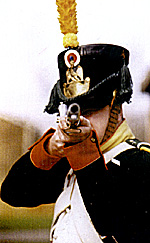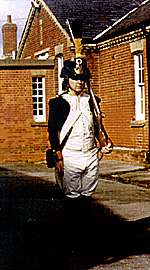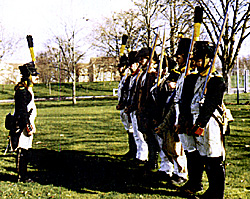 Numerous regiments in the Napoleonic Wars achieved the sort of fame that is remembered even today. For some, it was their elite status or glamorous uniforms. The Old Guard typifies the former case, the French Carabiniers the latter. Other units became famous for a single heroic exploit, for example the Scots Greys for their charge at Waterloo.
Numerous regiments in the Napoleonic Wars achieved the sort of fame that is remembered even today. For some, it was their elite status or glamorous uniforms. The Old Guard typifies the former case, the French Carabiniers the latter. Other units became famous for a single heroic exploit, for example the Scots Greys for their charge at Waterloo.
But there are regiments that achieved high renown in their day and are relatively unknown now. They are the units that won the battles, the ones that showed consistent elan and professionalism rather than carrying out a single outstanding action. Scan the orders of battle and you'll start to find them; the regiments that seem to turn up at every key battle.
The French 30eme de Ligne were one such. They were not caught up in the debacle of the Peninsular War, but instead, fought in Central Europe. They were present at almost every major battle from 1800 to 1812, and almost invariably had a key role. For much of this period, they were part of the Corps of Marshal Davout. This in itself shows an acknowledgement of their reputation.
Davout's Corps was the one Napoleon used to strike the decisive blows, as a spearhead, or to hold key positions in the line. Only the best regiments were selected for this formation. This article will illustrate a couple of key exploits of the 30eme rather than giving a full regimental history. To do the latter would probably take more space than I have available anyway.
EYLAU 1807
In 1807, at the battle of Eylau, Davout's corps joined the action late, smashing into the Russian flank after a tiring forced march. The Russians threw a mass of cavalry against the 30eme, who were outside the village of Serpallen.
I suspect that the wind and blizzards must have made musketry difficult. Every description of the battle I have read places the emphasis on cavalry and artillery, with musketry rarely mentioned. In these adverse conditions, and under heavy attack, when the eaglebearer fell wounded, the regiment started to waver. Fourrier (Quartermaster sergeant) Morin seized the Eagle, and to encourage the regiment, threw himself upon the Russians. This steadied the men's nerves, but Morin was surrounded by sabre wielding Russian horsemen and became involved in a fierce struggle.
Covered with numerous sabre wounds, he fell to the ground, pushing the precious Eagle into the snow under his body until the rest of the 30eme forced the Russians to retreat. Before fainting through loss of blood, Morin was able to show his comrades how he had hidden the Eagle.
This episode shows the elan of the 30eme, in that they were even prepared to attack cavalry in order to save their Eagle, on one of the most trying battlefields of the Napoleonic Wars.
The story does, in fact have a happy ending; Morin recovered from his wounds, was promoted to Sergeant Major, awarded the Legion D'Honneur on 14th April 1807 and survived the rest of the Napoleonic Wars to finish up with the rank of Captain.
RUSSIA 1812
 When they crossed the Nieman in June 1812 as part of Napoleon's invasion of Russia, the 30eme were 93 officers and 3715 men strong, part of Morand's Division of I Corps under Davout. With attrition, detachments and casualties at Smolensk, I estimate that the regiment entered the field of Borodino on 7th September with some 1200-1500 men, although I have not found a return to show an exact figure.
When they crossed the Nieman in June 1812 as part of Napoleon's invasion of Russia, the 30eme were 93 officers and 3715 men strong, part of Morand's Division of I Corps under Davout. With attrition, detachments and casualties at Smolensk, I estimate that the regiment entered the field of Borodino on 7th September with some 1200-1500 men, although I have not found a return to show an exact figure.
The 30eme were the lead regiment in the first serious attack on the Great Redoubt. Under the direct command of General de Brigade Bonamy, the regiment advanced on this formidable position. Despite coming under intense artillery fire, first roundshot and then canister, they maintained their advance. Bonamy halted the regiment within canister range to reform and then threw the regiment into the assault.
They overran a line of Russian infantry and then stormed up the glacis of the redoubt. Climbing in through the embrasures, the men found themselves in a ferocious hand to hand melee with Russian artillerists. After a short but violent struggle, the Russians were driven out and the 30eme had taken the redoubt.
Unfortunately, they were unable to hold it for long; the 12th and 26th Russian Divisions and various other Russian units all simultaneously counter-attacked. After another savage bout of melee the 30eme were forced to withdraw. At the bottom of the glacis, the survivors reformed for another attack, but the rest of Morand's division were not in a position to give them any support, and the remains of the regiment fell back to the rear, taking no further part in the battle.
There were 268 survivors around the Eagle at this point, and they had lost 44 officers killed and wounded. They still maintained their elan, and were able to march proudly under their Eagle.
Among the dead was Chef de Bataillon Flaige. As a young liutenant, he had fought in the Revolution, being commended for a rearguard action at Lofurt in 1797, and at Auerstadt as a captain had been specifically mentioned by Colonel Valterre in his report to General de Division Morand.
The 30eme carried on to Moscow with the rest of the Grands Armee, where they were probably joined by outlying detachments and possibly a small number of reinforcements. They then suffered the ordeal of the Retreat, retaining their discipline long after most other units had dissolved. By the time of the Berezina crossing, there were still 143 men under arms, although shortly afterwards, they too had dispersed to find forage.
THE 30EME RE-ENACTMENT UNIT
The above actions will give you some idea of what the 30eme were aboui, and why, when a small group of us started to discuss forming a French re-enactment unit in the winter of 1996-97, this was a regiment which we kept finding ourselves drawn to.
We wanted to form a re-enactment unit where the quality of drill and accurate appearance were the main standards we would apply to ourselves. We also wished to do this as a voltigeur unit, the only one currently represented in English re-enactment. This gives us the advantages of a really flashy uniform and being able to operate in skirmish order as light troops. Correspondingly, it means we needs to be really good at what we do, including carrying out all the standard evolutions of line troops. We primarily represent the regiment as it appeared in 1810-12.
We train intensively through the winter, using the original drill manual of the French infantry of the period, as well as making the majority of our kit and uniforms 'in-house'. Unlike many re-enactment units, we aim to recruit the enthusiastic rather than the rich. Rather than taking an attitude of 'welcome, now go and buy your kit', we can equip members totally out of depot, and encourage members to learn the skills to make their own uniforms should they wish. If a member wishes to be equipped from depot indefinitely, that is not a problem, although we do ask members to provide their own muskets and the relevant licenses.
 Now, a couple of years down the line, we are still a fairly new unit in re-enactment terms, but growing rapidly and looking for recruits in the south of England. We attend re-enactment events in England and Europe. We will most certainly be at Waterloo in 2000 for what promises to be the biggest Napoleonic event to date; now is a good time to join us in order to be trained and ready for it.
Now, a couple of years down the line, we are still a fairly new unit in re-enactment terms, but growing rapidly and looking for recruits in the south of England. We attend re-enactment events in England and Europe. We will most certainly be at Waterloo in 2000 for what promises to be the biggest Napoleonic event to date; now is a good time to join us in order to be trained and ready for it.
By way of a coincidence, there is also an Australian 30eme, which formed at about the same time as ourselves, but each without knowing of the other's existence until recently. They re-enact as grenadiers, and we're really hoping they can get over for Waterloo so that we can work together. Now we've got voltigeurs and grenadiers, how about someone in America or Europe setting up a fusilier company of the 30eme .....
APPENDIX I
COLONELS OF THE 30eme DE LIGNE 1791 - De Baudre 1792 - Termet de Laubadiere 1793 - Dumas 1796 - Valterre (Promoted General de Brigade January 1808, sent off as governor of Palma Nuova) January 1808 - Baron Joseph Antoine Rene Joubert 1811 - Baron Charles Joseph Buquet 1812 - Ranand (or could be Ramaud; the writer of the regimental history should have been a doctor with that handwriting 1)
APPENDIX II
MAIN ACTIONS 1798-1815 1798-1800 Naples, Trebbia, Novi, Marengo 1805 Ulm, Lambach, Austerlitz 1806 Auerstadt 1807 Heilsberg, Eylau 1809 Landshut, Eckmuhl, Essling*, Wagram 1812 Smolensk, Borodino, Wiasma, Krasnoi 1813-14 Siege of Hamburg 1815 Ligny, Wavre *The 4th battalion only were part of Demont's Division at Aspern-Essling..
PRIMARY SOURCES
Regimental History Regimental histories are available from the French military archives at Vincennes, although they do charge for copies (we were charged 1.50F per page plus 35.00F post & packing).Francois, Charles An officer of the 30eme for a large portion of the Napoleonic Wars, wrote a lengthy set of memoirs. I haven't been able to lay my hands on a set, so sadly have to rely on extracts published in secondary works. The overall impression I get of his work is that there is lots of useful detail, but that he works hard to glorify the role he himself played.
Musee de l'Armee at the Invalides, Paris. Nothing specifically 30eme, but houses a large collection of French Napoleonic uniforms. Essential visiting if you want to look at the original thing.
SECONDARY SOURCES
You'll find the 30eme turning up in orders of battle, and mentioned in passing in numerous books about the period. Some of the better references I've come across include;
Britten Austin, Paul 1812, The Great Retreat; contains numerous excerpts from the memoirs of Charles Francois.
Duffy, C. Borodino. Probably my favourite book on the Napoleonic period! Has a lot of detail for such a relatively short book, and is written in a very readable style.
Nafziger, G. Napoleon at Leipzig; primarily covering the 1813 German campaign, but a book I would highly recommend; page 280 mentions an engagement at Stecknitz near Hamburg where 2 companies of 30eme voltigeurs held off a Russian and Hanoverian force of nearly divisional size.
Uffindel, A The Eagle's Last Triumph. More useful excerpts from Charles Francois.
Von Pivka, O. Armies of 1812 Volume 1. A gold-mine of solid facts and statistics, Most of the second half is made up of orders of battle for each of the French Corps for Napoleon's invasion of 1812, showing march-in strengths in officers, men and horses in exhaustive detail, drawn from original returns.
RE-ENACTMENT CONTACT
30eme de Ligne (UK based voltigeur company)
Sean Bissett-Fowell 178 Guildford Park Avenue, Guildford, Surrey, GU2 5NH Tel. 01483 531867, e-mail sean.30eme@net.nti.com
Back to Age of Napoleon 30 Table of Contents
Back to Age of Napoleon List of Issues
Back to MagWeb Master List of Magazines
© Copyright 1999 by Partizan Press.
This article appears in MagWeb (Magazine Web) on the Internet World Wide Web.
Other military history articles and gaming articles are available at http://www.magweb.com